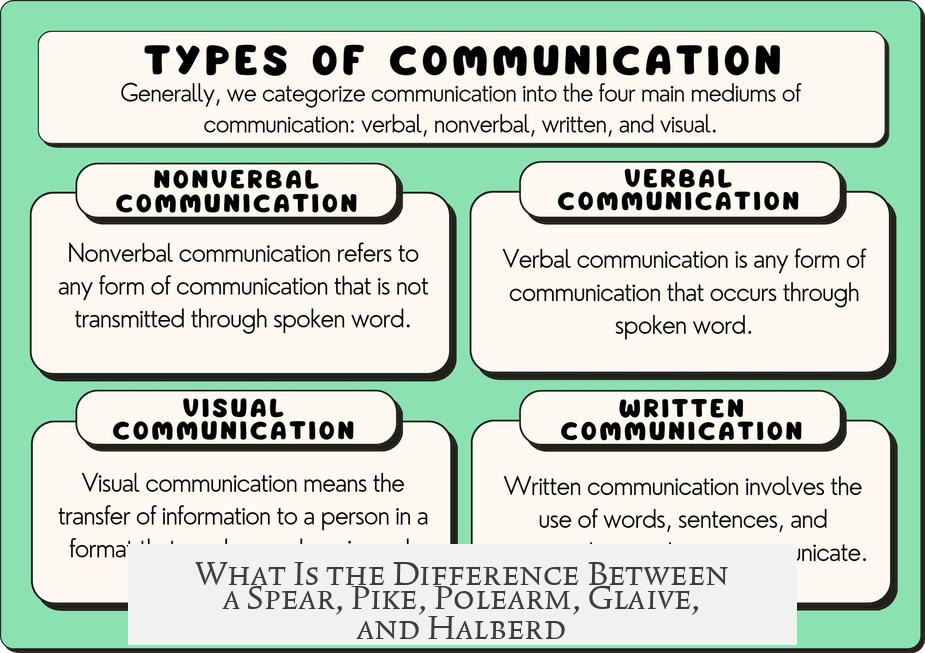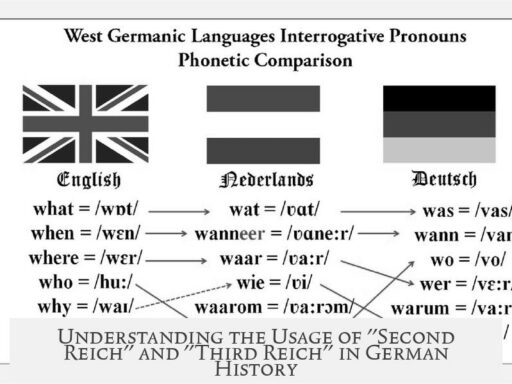The difference between a spear, pike, polearm, glaive, and halberd lies primarily in their structure, length, function, and design specifics, despite all falling under the broad category of polearms—hafted weapons with elongated shafts used for combat.
All these weapons are types of polearms, meaning they consist of a long handle (shaft or haft) with a weaponized head. The term “polearm” broadly includes spears, pikes, glaives, halberds, and other staff-like weapons. Some sources exclude spears or pikes from the polearm category, but accurate usage includes them all.
The spear is a very versatile and difficult-to-define weapon. It typically features a pointed head for thrusting, but spearheads can vary greatly. They may be simple conical points, single-edged, double-edged, or even multi-pronged. Spear lengths vary widely — from just a few feet to about 18 feet or more. Some spearheads can cut as well as thrust, blurring lines between spears and cutting polearms. The essential characteristic is a hafted weapon focused on thrusting, but some spears also cut.
The pike is essentially a subtype of spear, distinguished by its extreme length and two-handed use. Generally, pikes range from 15 to 25 feet long. A pike’s extraordinary length aims to keep enemies at a distance, especially cavalry. Some shorter pikes, sometimes called half-pikes (around 10 feet), serve specific roles like naval boarding. Pike design focuses on reach and thrusting power over cutting ability.
While not centrally compared here, the lance is worth noting. It refers to a cavalry spear, making it distinct from infantry-used spears or pikes. This term helps differentiate the weapon’s use and context rather than its basic design.
Halberds belong to the category of cut-and-thrust polearms. A halberd typically combines an axe-like blade for cutting with a vertical spike for thrusting. This design dates back to medieval European warfare. Some late-halberd variants lack an elongated axe blade, resembling pollaxes. Halberds attach their head with two metal bands or eyes around the shaft, securing both the axe blade and spike. The vertical thrusting spike distinguishes the halberd from similar weapons.
The glaive is another cutting and thrusting polearm with a long blade on the end of a shaft, usually up to 6.5 feet (about 2 meters). Its blade is generally single-edged with a convex cutting edge and a straight or slightly concave back. Unlike halberds, going from the glaive’s blade tip doesn’t extend a separate spike; the tip is simply the end of the blade. This means the glaive can thrust or cut, but it lacks the halberd’s vertical thrusting spike. The glaive’s blade attaches to the shaft via a single socket rather than multiple eyes like the halberd. This simpler head attachment highlights structural differences.
A quick comparison highlights the key distinctions:
| Weapon | Length | Blade Type | Primary Use | Distinct Features |
|---|---|---|---|---|
| Spear | Varies; few to ~18 feet | Pointed, may be sharp or unsharpened | Thrusting (some cutting) | Simple thrust head, broad variations |
| Pike | 15-25 feet | Pointed | Long-range thrusting | Very long, two-handed spear subtype |
| Halberd | 6-8 feet typical | Axe blade + vertical spike + hook or spike | Cut and thrust | Separate thrust spike; double metal eyes |
| Glaive | Up to 6.5 feet | Single-edged cutting blade, often curved | Cut and thrust | Blade ends tip; single socket attachment |
| Polearm | Varies widely | Any hafted head including blades and points | General term for all staff weapons | Umbrella category |
Additional related polearms include the bill, which has a concave cutting edge with a straight bottom edge and upward-curved top edge. Some halberds also have concave blades but look more like axes.
Classification among these weapons is complicated by overlapping designs and vague distinctions. For example, some late halberds resemble pollaxes. Some non-European weapons like the naginata or guandao often get inaccurately labeled as halberds, while their design fits lire glaives better.
Because of these ambiguities, many writers use polearm as a catch-all term when specifics are unclear. Weapon variations, regional differences, and evolving designs all contribute to blurred lines. Exact categorization sometimes depends on subtle features like blade attachment, presence of separate thrust spikes, blade shape, and length.
- Spears are generally thrusting weapons with varied blade forms and lengths.
- Pikes are very long two-handed spears emphasizing reach.
- Halberds combine axe-like cutting blades with a separate thrust spearhead, attached by two metal bands.
- Glaives have a long, single-edged cutting blade ending in a tip, attached by a single socket, lacking a separate thrust spike.
- Polearm is the overarching category encompassing all these staff weapons.
- Weapon classifications often overlap, making precise distinctions difficult.
What Is the Difference Between a Spear, Pike, Polearm, Glaive, and Halberd?

Short answer: They’re all polearms—hafted or staff weapons—but differ mainly by shape, size, and purpose. A spear is a basic thrusting weapon, a pike is a very long spear for two hands, a polearm is the broad category, a glaive is a long cutting blade on a staff, and a halberd combines an axe blade and a spike for both cutting and thrusting.
Now that we have the basics, let’s dive deeper. Ready to untangle this medieval melee? Grab your imaginary weapon of choice, and let’s go.
Understanding Polearms: The Umbrella Term
First things first: **“polearm”** is the big umbrella here. Every weapon we’ll talk about fits under this term. Polearms are hafted weapons, basically a blade or point attached to a long wooden shaft or pole.
Some writers exclude spears and pikes from being polearms, but that’s like saying pizzas aren’t food. They really do belong here.
- Spears, pikes, glaives, halberds—all polearms.
- Polearms are designed for reach, hitting enemies from a distance.
- Some polearms lean toward thrusting, some toward cutting, some do both.
Think of polearms as the medieval equivalent of Swiss Army knives. Versatile and effective.
Spear: The Basic Thrusting Stick
Spears are tricky to pin down because they come in many shapes. Imagine the simplest, most useful weapon imaginable: a sharp end on a stick, perfect for poking.
A spear usually has a pointed head which might be unedged (like a cone), single or double-edged, or even multi-pointed. Length varies wildly, from a few feet to about 18 feet. Surprisingly, not all spears are just for stabbing—a few have edges that can cut.
In essence, if it’s a hafted weapon primarily built for thrusting, it’s a spear.
The Pike: The Giant Spear Among Infantry
Now, take a spear, make it really long—like 15 to 25 feet—and you’ve got a pike. Think of it as the spear’s big, muscle-bound cousin.
Pikes are designed for two-handed use and often held in ranks by infantry to stop cavalry charges or to fight other foot soldiers at a distance. The length gives soldiers a striking range advantage.
There are also shorter variants, called half-pikes or naval boarding pikes, about 10 feet long, used in ship battles.
Halberd: The Swiss Army Knife of Polearms

If you like combos, the halberd is your dream weapon. According to historian John Waldman, it has an axe-like blade for cutting, paired with a vertical spike for thrusting. Imagine the power of an axe blow plus the reach and precision of a spear thrust—all in one tool.
Some later halberds look less like an axe and more like a pollaxe (another polearm variety), blurring lines but keeping the same core idea: cut and thrust.
Key distinct feature: The halberd’s spike and cutting edge are two separate parts. It also attaches to the shaft with two metal bands called “eyes,” ensuring durability during battle.
Glaive: The Long Cutting Blade on a Staff
The glaive is a different beast. It wears a long, single-edged cutting blade on a pole—kind of like a sword on a stick.
Unlike the halberd’s separate spike, the glaive’s tip may serve as a thrusting point if it’s pointed—but it’s really just the end of the cutting blade. Some glaives have a curved edge at the tip that’s poor for stabbing.
The blade attaches to the shaft through a single socket, sort of a “clip-on” style, unlike the halberd’s two-eye metal bands.
One way to tell a glaive from a spear? The glaive has a long, broad blade maximizing cutting power, while most single-edged spears have shorter, stabbing-focused heads.
So Why Does All This Matter?
Knowing these differences lets you decode medieval battlefields, understand historical artwork accurately, or impress friends during fantasy debates.
It also helps to recognize that many polearms blur lines. Sometimes you see weapons labeled inconsistently. For example, the bill looks like a close cousin to halberds but with subtle blade shape differences. Or Asian weapons like the naginata get called “halberds,” but they really fit better as glaives.
In the end, **if you’re ever stuck, calling it a polearm is your safest bet.**
Summary Table: The Polearm Lineup
| Weapon | Length | Main Use | Blade Type | Attachment | Distinctive Feature |
|---|---|---|---|---|---|
| Spear | Few to ~18 feet | Thrusting (some cutting) | Pointed, various edges | Simple socket | Basic thrusting staff weapon |
| Pike | 15-25 feet | Long reach thrusting | Pointed | Simple socket | Very long, two-handed spear |
| Halberd | 5-6 feet typically | Cut and thrust | Axe blade + spike | Two metal “eyes” | Separate spike and axe blade |
| Glaive | ~6 feet (up to 2 m) | Cut and some thrust | Long cutting blade | Single socket | Blade tip is part of cutting edge |
Parting Thoughts
So, the next time you watch a medieval show or read a fantasy novel, you’ll know the subtle but important differences between these mighty polearms.
Ever wonder how foot soldiers threw back horse charges? Grab a pike. Need a versatile weapon for slashing and stabbing? Halberd’s your pal. Want graceful slicing ability from afar? Pick up a glaive. Just need a good, simple spear? That works too.
Each weapon carved its niche in history, adapting to the evolving art of warfare. Their differences reflect what armies valued: reach, cutting power, thrusting ability, and durability.
And if you ever see one at a museum, you can nod knowingly and say, *“Ah, that’s a glaive, not a halberd!”* Just don’t wave it around—it won’t be appreciated.




